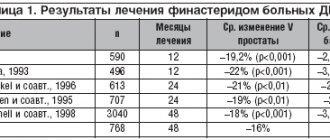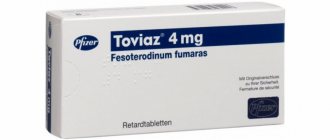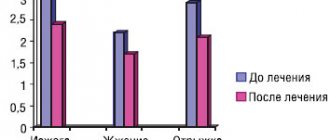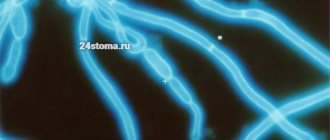Compound
Depending on the form of release, Truskal may contain varying amounts of both active and auxiliary compounds.
5 mg. chlorprothixene hydrochloride, as well as lactose monohydrate, croscarmellose sodium, magnesium stearate, talc, copovidone, corn starch, microcrystalline cellulose, as well as 85% glycerol are contained in one tablet (diameter 6 mm), coated with a dark brown film shell, which contains includes dye TM 1030, E171, 172 (Opadry OY-S-9478).
15 mg. chlorprothixene hydrochloride , as well as croscarmellose sodium, corn starch, talc, 85% glycerol, lactose monohydrate, magnesium stearate, copovidone and microcrystalline cellulose are contained in one brown film-coated tablet (diameter 7 mm), which contains Opadry dye OY-S-9478.
25 mg. chlorprothixene hydrochloride , as well as magnesium stearate, lactolose monohydrate, copovidone, 85% glycerol, croscarmellose sodium, microcrystalline cellulose and talc can be contained in one round and biconvex tablet, the film coating of which includes red and black iron oxide, titanium dioxide, macrogol and dye Opadry OY-S-9478.
Pharmacodynamics and pharmacokinetics
Due to the fact that Truxal thioxanthene derivative , experts classify this drug as an effective antipsychotic drug . an antipsychotic effect because the active compounds contained in the drug affect dopamine receptors .
Truxal blocks these receptors (α1 - adrenergic receptors, 5-HT2 - receptors and H1 - histamine receptors), thereby exhibiting its analgesic as well as antiemetic properties. Since the drug is rapidly absorbed, the maximum concentration of medicinal compounds in the blood is achieved within two hours.
The medicine is excreted from the body through urine and feces. Truxal penetrates the placental barrier , i.e. the medicine is excreted through breast milk.
Indications for use
Truxal is taken for:
- manic states;
- psychosis;
- hyperactivity;
- schizophrenia;
- withdrawal syndrome;
- confusion in old age ;
- depression;
- violation of child behavior;
- psychosomatic disorders.
In addition, the drug is used in combination with analgesics for complex therapeutic treatment of pain.
Contraindications
Truxal is contraindicated for:
- any forms of central nervous system depression , for example, alcohol, toxic or drug intoxication;
- comatose states;
- malfunctions of the hematopoietic system ;
- vascular collapse;
- pheochromocytoma;
- hypersensitivity.
In addition, the drug is prohibited from being taken while breastfeeding , and it is prohibited from being prescribed to women during pregnancy .
Side effects
From the heart: often (≥ 1/100 to < 1/10) - tachycardia, increased heartbeat.
From the nervous system: very often (≥ 1/10) - drowsiness, dizziness; often (≥ 1/100 to < 1/10) - dystonia, headaches.
Visual disturbances: often (≥ 1/100 to < 1/10) - disturbance of accommodation, vision.
From the gastrointestinal tract: very often (≥ 1/10) - dry mouth, hypersecretion of saliva; often (≥ 1/100 to < 1/10) - constipation, dyspepsia, nausea.
From the skin and subcutaneous tissue: often (≥ 1/100 to < 1/10) - hyperhidrosis.
Musculoskeletal disorders: often (≥ 1/100 to < 1/10) - myalgia.
Metabolic disorders: often (≥ 1/100 to < 1/10) - increased appetite, weight gain.
Side effects
Truxal has the following side effects:
- dry mouth;
- drowsiness;
- sweating;
- tachycardia;
- disorientation.
The above side effects of the drug usually occur at the very beginning of the therapeutic course of treatment and disappear gradually over time. , dysmenorrhea, hypotension may occur , and rashes may appear on the skin.
Use of Truxal in psychiatric patients of advanced age
Yakovleva O.B.
Scientific Center for Mental Health of the Russian Academy of Medical Sciences, Moscow
As is known, the treatment of mental pathology in late age is associated with significant difficulties caused by the direct influence of this age period. The main ones include: poor tolerability of psychopharmacotherapy with an increased risk of side effects and complications, high comorbidity with a variety of somatic diseases that create additional restrictions in the choice of psychotropic drugs, and, finally, a high frequency of “atypical” mixed and polymorphic symptoms characteristic of mental illnesses late age . A typical example of the latter situation is late-onset depression , which often combines in its clinical picture components of anxiety, hypochondriacal, somatization, delusional and transient cognitive disorders. common category of secondary mental conditions (mental disorders in vascular, atrophic dementia, vascular encephalopathies, etc.) can be considered even more difficult for pharmacotherapy
Despite the impressive advances in psychopharmacology and the creation of new promising drugs (“atypical” neuroleptics, fourth-generation antidepressants, etc.), an “ideal” antipsychotic for gerontopsychiatry that harmoniously combines both effectiveness and safety has not yet been developed. In this regard, it is quite reasonable to recall old and familiar drugs, the scope of which turned out to be unfairly narrowed due to the “fascination” with new ones. Such drugs, of course, include the thioxanthene neuroleptic chlorprothixene , which has a number of properties that are very useful in gerontopsychiatry. Chlorprothixene was originally developed by the pharmaceutical company Lundbeck (Denmark). In Russia, the original Danish chlorprothixene was registered in 2000 under the trade name Truxal , tablets of 5, 15, 25 and 50 mg. Unlike other classical antipsychotics, including the thioxanthene series, Truxal , in addition to the dopamine system, has a much greater effect on adrenal, cholinergic and histamine receptors, and therefore in many reference books it is designated as an adrenergic and cholinergic blocker . It is these properties of Truxal that determine both its advantages and disadvantages. The first include the wide possibilities of using a drug that has a rapid and powerful sedative effect, almost 5 times greater than the effect of chlorpromazine, as well as a more delayed antipsychotic and even a certain antidepressant effect. The advantage of the drug can also be considered the possibility of its safe and effective use in combination therapy with many antidepressants and antipsychotics. A relative disadvantage is a wider range of side effects of Truxal , including, in addition to rare and mild extrapyramidal disorders, muscarinic (dry mouth, accommodation disturbances, tachycardia, constipation, etc.), b1-adrenergic (hypothesis, including orthostatic ) and antihistamine side effects (weakness, drowsiness, muscle relaxation, etc.). Since the severity of the side effects of Truxal directly depends on the dose of the drug, its maximum dosages (600 mg/day and above), which provide the most effective antipsychotic effect, are practically not used due to the threat of developing collaptoid states. In contrast to the maximum, low and medium dosages of Truxal (from 10 to 100 mg/day) are completely safe for use even in elderly and senile patients .
Our experience with the use of Truxal shows that it can be successfully used much more widely than only for the traditional treatment of persistent insomnia in elderly and senile mentally ill patients Medium and low dosages of Truxal, which preserve the sedative, anti-anxiety and peculiar “antidepressive” effects of the drug and allow its use in combination with other psychotropic drugs (for example, antidepressants), make of conditions with mixed anxiety and depression that are so common in late symptoms. It should be noted that the tablet forms of Truxal, 5 and 15 mg, patients In particular, the combination of Truxal (in dosages from 15 to 45 mg/day) with antidepressants in the treatment of patients with major depression with mixed depressive and anxiety symptoms under the age of 70 years is highly effective. In patients over 70 years of age, in the treatment of depression with an anxiety component against the background of vascular encephalopathy and initial signs of psychoorganic decline, the use of Truxal is also quite successful, although it is recommended to reduce the dosage to 15-25 mg/day to avoid unwanted relaxing and hypotensive effects.
The use of Truxal in ultra-low dosages (10-15 mg/day) can be recommended for long-term use in the correction of episodes of anxious arousal with behavioral disorders and elements of psychotic disorders (delusions of harm, elements of agitation, “getting ready” for travel, gross psychopathic behavior, etc. .) in patients with senile and senile-vascular dementia. However, it should be remembered that the use of Truxal to relieve severe psychomotor agitation with acute states of confusion in such patients is undesirable, since it requires a significant increase in dosages of the drug and, accordingly, causes increased side effects (severe hypotension, increased muscle weakness, falls with the threat of fractures).
At the same time, the hypotensive (side) effect of Truxal can be used to treat mental pathology with concomitant hypertension. Thus, in several elderly patients (68-74 years old) with hypertension and secondary anxiety disorders (panic attacks combined with the development of severe hypertensive crises), the use of small doses of Truxal (10-15 mg/day) allowed not only to eliminate anxiety disorders, but and stabilize blood pressure.
It should also be noted that low and medium doses of Truxal are well tolerated by elderly patients . Among our patients, the extrapyramidal side effects of Truxal were not noted at all; the severity of muscarinic effects was minimal and was not noticed by the patients themselves. Quite often the observed phenomena of lethargy, drowsiness and muscle weakness were insignificant and disappeared completely after the first days of use, or disappeared after reducing the dosage. Only patients with pronounced signs of vascular encephalopathy had a tendency to develop or intensify their existing orthostatic hypotension, which required the initial use of ultra-low dosages of Truxal (10-15 mg/s), as noted above.
Thus, we can say that the currently observed unjustified narrowing of the scope of Truxal, in our opinion, is a consequence of the initial attitude towards it as a pronounced antipsychotic, high dosages of which are poorly tolerated by patients. In contrast, small and medium dosages of Truxal are completely safe and allow it to be successfully and effectively used in gerontopsychiatry as a broad-spectrum antipsychotic in the treatment of anxiety, anxiety-somatization and anxiety-depressive disorders, as well as agitated states with behavioral disorders in dementia even in patients with fairly severe comorbid somatic pathology.
Instructions for use of Truxal (Method and dosage)
In accordance with the instructions for Truxal, treatment of manic states, schizophrenia and other psychoses should begin with a dosage not exceeding 100 mg. drug per day. The dose should be increased gradually, usually to a maximum of 300 mg. in a day.
Dosage 500 mg. Truxala three times a day for a week will help relieve withdrawal symptoms due to alcoholism or drug addiction.
In a state of confusion, elderly patients are prescribed up to 90 mg. drug per day. For insomnia, you can take up to 30 mg. Truxala approximately one hour before bedtime. Depressive conditions and other psychosomatic disorders are treated with daily dosages not exceeding 90 mg of the drug. For pain, up to 300 mg is prescribed. Truxala.
Mode of application
The dosage should be selected individually. The initial dose should be low, then the dose should be increased relatively quickly until the optimal therapeutic effect is achieved.
Schizophrenia and other psychoses with psychomotor restlessness, agitation and anxiety disorder. The initial dose is 50-100 mg/day with a gradual increase until the optimal effect is achieved. The usual optimal dose is 300 mg per day; in some cases, it can be increased to 1200 mg/day, if necessary.
The maintenance dose is usually 100-200 mg/day.
Due to the strong sedative effects, lower doses should be taken during the day and higher doses in the evening.
Overdose
If the dosage of Truxal is exceeded, the following symptoms may appear:
- convulsions;
- coma;
- drowsiness;
- extrapyramidal syndromes;
- hyperthermia;
- shock;
- hypothermia.
In case of an overdose of Truxal, first of all, patients are washed with gastric lavage , and then, providing support for the cardiovascular and respiratory systems, symptomatic treatment is carried out.
Interaction
Since the inhibitory effect on central nervous system , it is not recommended to take Truxal together with ethanol-containing and sedative drugs , as well as analgesics, anesthetics, hypnotics and antipsychotic drugs.
Drugs containing chlorprothixene should not be used simultaneously with antiparkinsonian, anticholinergic and antihistamine drugs. It is forbidden to use adrenaline together with Truxal to avoid tachycardia and hypotension .
Patients with epilepsy when taking the drug need to adjust the dosage of antiepileptic drugs , since this medicine helps lower the seizure threshold. The effectiveness of Levodopa is reduced when taking Truxal. Extrapyramidal disorders may occur when this medicine is used together with Reserpine, Phenothiazine, Haloperidol and Metoclopramide.
special instructions
With caution, Truxal should be prescribed to patients with epilepsy, atherosclerosis, Parkinson's disease, diseases of the cardiovascular system , diabetes mellitus , hypertrophy and dysfunction of the liver and kidneys .
When performing a pregnancy test, the drug may give a false positive result. In addition, the drug affects the QT interval during an electrocardiogram study. It is prohibited to drink alcoholic beverages while taking the drug.
While using this medicine, you should avoid driving vehicles and performing work related to the maintenance of potentially dangerous machinery.
Features of application
Pregnant
Clinical experience with pregnant women is limited. Chlorprothixene should not be prescribed during pregnancy unless the expected benefit to the patient outweighs the possible risk to the fetus.
Breastfeeding may continue during treatment with chlorprothixene if clinically important, but monitoring the infant is recommended, especially in the first four weeks after birth.
Cases of hyperprolactinemia, galactorrhea, amenorrhea, lack of ejaculation and erectile dysfunction have been reported. These conditions can have a negative impact on female and/or male sexual function and fertility. If clinically significant hyperprolactinemia, galactorrhea, amenorrhea, or sexual dysfunction occurs, dose reduction (if possible) or discontinuation should be considered. The effects after stopping the drug are reversible.
Children
Chlorprothixene is not recommended for use in children under 18 years of age, as there are insufficient clinical studies of efficacy and safety in children and adolescents.
Drivers
Truxal is a sedative. Truxal, like major mental illnesses, can impair attention and responsiveness and also affect behavior and psychomotor function. Patients taking Truxal should not drive vehicles or operate dangerous machinery until they know their personal reaction to the medicine.
Truxal price, where to buy
On average, the price of Truxal (pack of tablets of 50 mg each, 50 pieces) does not exceed 450 rubles.
- Online pharmacies in RussiaRussia
- Online pharmacies in UkraineUkraine
ZdravCity
- Truxal tablets p.p.o.
50 mg 50 pcs. Lundbeck 468 rub. order - Truxal tablets p.p.o. 25 mg 100 pcs.Lundbeck
RUR 677 order
Pharmacy Dialogue
- Truxal (chloroprotexene) (tablet p/o 25 mg No. 100) Lundbeck
RUR 643 order
- Truxal (chloroprotexene) (tablet p/o 50 mg No. 50) Lundbeck
RUB 473 order
show more
Pharmacy24
- Truxal 50 mg No. 50 tablets H. Lundbeck A/S, Denmark
358 UAH. order - Truxal 25 mg No. 100 tablets H. Lundbeck A/S, Denmark
353 UAH. order
Note!
Description of the drug Truxal table. p/o 25 mg No. 100 on this page is a simplified author’s version of the apteka911 website, created on the basis of the instructions for use.
Before purchasing or using the drug, you should consult your doctor and read the manufacturer's original instructions (attached to each package of the drug). Information about the drug is provided for informational purposes only and should not be used as a guide to self-medication. Only a doctor can decide to prescribe the drug, as well as determine the dose and methods of its use.










